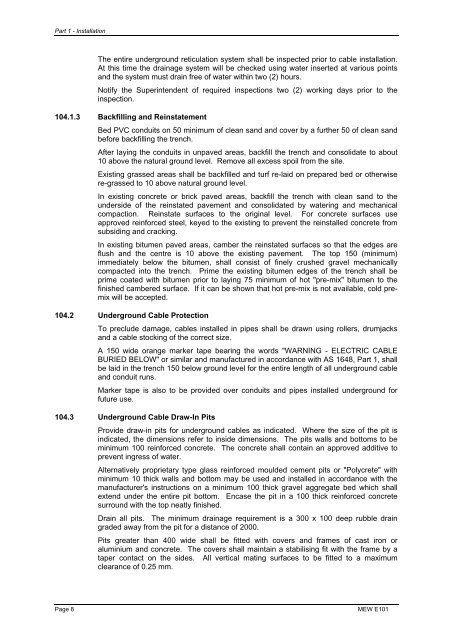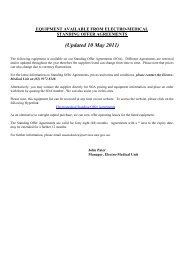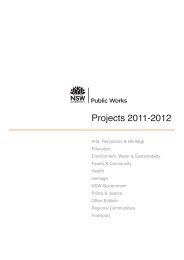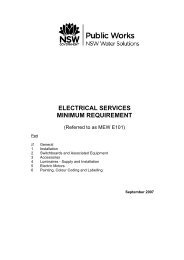Download MEW E101 April 2013 (pdf, 280kb) - NSW Public Works
Download MEW E101 April 2013 (pdf, 280kb) - NSW Public Works
Download MEW E101 April 2013 (pdf, 280kb) - NSW Public Works
Create successful ePaper yourself
Turn your PDF publications into a flip-book with our unique Google optimized e-Paper software.
Part 1 - Installation<br />
The entire underground reticulation system shall be inspected prior to cable installation.<br />
At this time the drainage system will be checked using water inserted at various points<br />
and the system must drain free of water within two (2) hours.<br />
Notify the Superintendent of required inspections two (2) working days prior to the<br />
inspection.<br />
104.1.3 Backfilling and Reinstatement<br />
Bed PVC conduits on 50 minimum of clean sand and cover by a further 50 of clean sand<br />
before backfilling the trench.<br />
After laying the conduits in unpaved areas, backfill the trench and consolidate to about<br />
10 above the natural ground level. Remove all excess spoil from the site.<br />
Existing grassed areas shall be backfilled and turf re-laid on prepared bed or otherwise<br />
re-grassed to 10 above natural ground level.<br />
In existing concrete or brick paved areas, backfill the trench with clean sand to the<br />
underside of the reinstated pavement and consolidated by watering and mechanical<br />
compaction. Reinstate surfaces to the original level. For concrete surfaces use<br />
approved reinforced steel, keyed to the existing to prevent the reinstalled concrete from<br />
subsiding and cracking.<br />
In existing bitumen paved areas, camber the reinstated surfaces so that the edges are<br />
flush and the centre is 10 above the existing pavement. The top 150 (minimum)<br />
immediately below the bitumen, shall consist of finely crushed gravel mechanically<br />
compacted into the trench. Prime the existing bitumen edges of the trench shall be<br />
prime coated with bitumen prior to laying 75 minimum of hot "pre-mix" bitumen to the<br />
finished cambered surface. If it can be shown that hot pre-mix is not available, cold premix<br />
will be accepted.<br />
104.2 Underground Cable Protection<br />
To preclude damage, cables installed in pipes shall be drawn using rollers, drumjacks<br />
and a cable stocking of the correct size.<br />
A 150 wide orange marker tape bearing the words "WARNING - ELECTRIC CABLE<br />
BURIED BELOW" or similar and manufactured in accordance with AS 1648, Part 1, shall<br />
be laid in the trench 150 below ground level for the entire length of all underground cable<br />
and conduit runs.<br />
Marker tape is also to be provided over conduits and pipes installed underground for<br />
future use.<br />
104.3 Underground Cable Draw-In Pits<br />
Provide draw-in pits for underground cables as indicated. Where the size of the pit is<br />
indicated, the dimensions refer to inside dimensions. The pits walls and bottoms to be<br />
minimum 100 reinforced concrete. The concrete shall contain an approved additive to<br />
prevent ingress of water.<br />
Alternatively proprietary type glass reinforced moulded cement pits or "Polycrete" with<br />
minimum 10 thick walls and bottom may be used and installed in accordance with the<br />
manufacturer's instructions on a minimum 100 thick gravel aggregate bed which shall<br />
extend under the entire pit bottom. Encase the pit in a 100 thick reinforced concrete<br />
surround with the top neatly finished.<br />
Drain all pits. The minimum drainage requirement is a 300 x 100 deep rubble drain<br />
graded away from the pit for a distance of 2000.<br />
Pits greater than 400 wide shall be fitted with covers and frames of cast iron or<br />
aluminium and concrete. The covers shall maintain a stabilising fit with the frame by a<br />
taper contact on the sides. All vertical mating surfaces to be fitted to a maximum<br />
clearance of 0.25 mm.<br />
Page 8<br />
<strong>MEW</strong> <strong>E101</strong>





